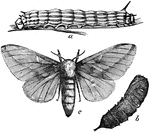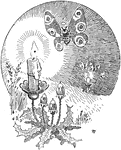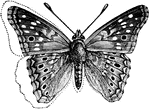
Female Gipsy Moth
Gipsy moth is the common name of liparis dispar. The female moth is larger and heavier than the male.…

Female Gipsy Moth
The antennae of female gipsy moths are usually slender. The moths fly by day and are often brightly…

Male Gipsy Moth
The wings of the gipsy moth are relatively weak. The antennae are feathered on either side.

Gooseberry or Magpie Moth
The Gooseberry or Magpie moth is often mistaken for a butterfly. The moth usually appears in the middle…
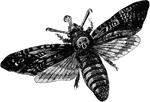
Death's-Head Hawkmoth
This insect is easily identified by the vaguely human skull-shaped pattern of markings on the thorax.

Humming Bird Hawk Moth
The humming bird hawk moth has long, narrow front wings. The front wings move rapidly causing the moth…

Hummingbird Hawk Moth
Hummingbird hawk moth is the common name of macroglossa stellatarum. This moth flies very fast. While…

Lackey Moth
Bombyx Neustria, or the lackey moth, lay their eggs on the twigs of various trees. When the larvae emerge…
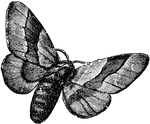
Lackey Moth
The lackey moth belongs to the same tribe as the gipsy moth, brown tail moth, gold tail moth, tiger…

Larva of Goat Moth
Goat moth caterpillars are destructive to timber and fruit trees. When fully grown the caterpillar is…
Caterpillar of the Leopard Moth
The larva, or caterpillar, of the leopard moth is whitish with black glossy spots. The caterpillar has…

Female Leopard Moth
The antennae if the female leopard moth are thread like. The wings are semi-translucent with thickly…

Male Gipsy Moth
The male gipsy moth is dark brown or smoky with zigzag darker markings and lighter shades. The antennae…

Moth
Lepidopterous insects, which are distinguished from butterflies in that the antennae taper to a point…

Moth (Male)
An illustration of a male moth. Most species of moth are nocturnal, but there are crepuscular and diurnal…

Codlin Moth and Grub
Caterpillar, larvae of the moth and butterfly, are harmful to plants. These caterpillars sucker feet…
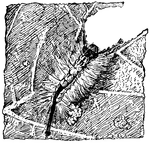
Tussock Moth Larva
The larva of the tussock moth bear several pencils of long black hairs placed at each end. The larva…
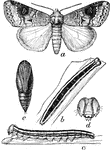
Moth Stages
"Mamestra legitima: a, adult; b, larva from above; c, same from side; d, head of same from front; e,…

Brown-tail Moth
The Brown-tail (Euproctis chrysorrhoea) is a moth of the family Lymantriidae. It is distributed throughout…
Eggs of Cankerworm Moth
An illustration of cankerworm moth eggs laid on an apple tree twig. Cankerworm moth eggs are typically…

Carpet Moth
Cidaria, a genus of moths characterized by having oblique bands with acute angles across the front wings.

Cecropia Moth
This moth has large wings, measuring five to six inches from tip to tip. It is found all across the…

Cecropia Moth
"The Cecropia Moth, A. Cecropia, is of a dusky reddish-brown; the wings expand six inches,…

Cecropia Moth
The cecropia moth is one of the largest moths found in North America. It is a member of the Saturniidae…
Larva of Cecropia Moth
An illustration of the larva of a ceropia moth. The cecropia moth is one of the largest moths found…
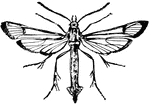
Clear-Winged Moth
"These are wasplike moths of brilliant colors and have transparent wings. They generally fly by day."…

Death's Head Moth
"The most remarkable species is the Death's Head Moth, Acherontia Atropos, a large kind,…

Death's Head Moth
"The Death's-head Moth is the European Acherontia Atropos, a hawk-moth with markings on the thorax resembling…
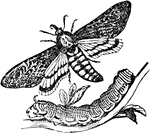
Death's Head Moth
"A species of Hawk-moth or lepidopterous insect of the family Sphingidae, not uncommon in some parts…

Death's Head Moth Caterpillar
"The Death's-head Moth is the European Acherontia Atropos, a hawk-moth with markings on the thorax resembling…
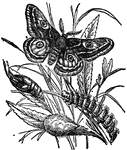
Emperor Moth
"The Emperor Moth, the general color greyish, with white hairs and purple tinges; wings with a hinder…

Fallweb Worm Moth
An illustration of a fallweb worm moth. Fall webworm, Hyphantria cunea, is a moth in the family Arctiidae…

Female Gipsy Moth
Female gipsy moths have large wings that are covered with small scales. The mouth is not able to bite.…
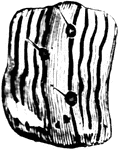
Eight-Spotted Forester
The adult Eight-Spotted Forester (Alypia octomaculata), a moth belonging to the Noctuidae family of…
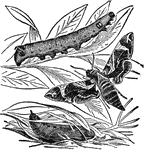
Hawk Moth
"Hawk Moth is a family of the lepidopterous insects, forming along with the clear winged moths and the…
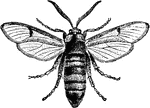
Hornet Moth
Also known as Sesia apiformis. A large moth with a striking imitation of a hornet. They are, however,…
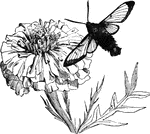
Hummingbird Moth
"A considerable number of insects belonging to Sphingina have transparents wings. Among them is the…

Lackey Moth
The Lackey moth, Malacosoma neustria, is a member of the genus Malacosoma, common across southern Britain…

Luna Moth
"Among the larger and more splendid moths of our own country is the Luna Moth, or Green Emperor Moth,…
